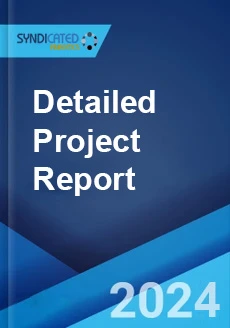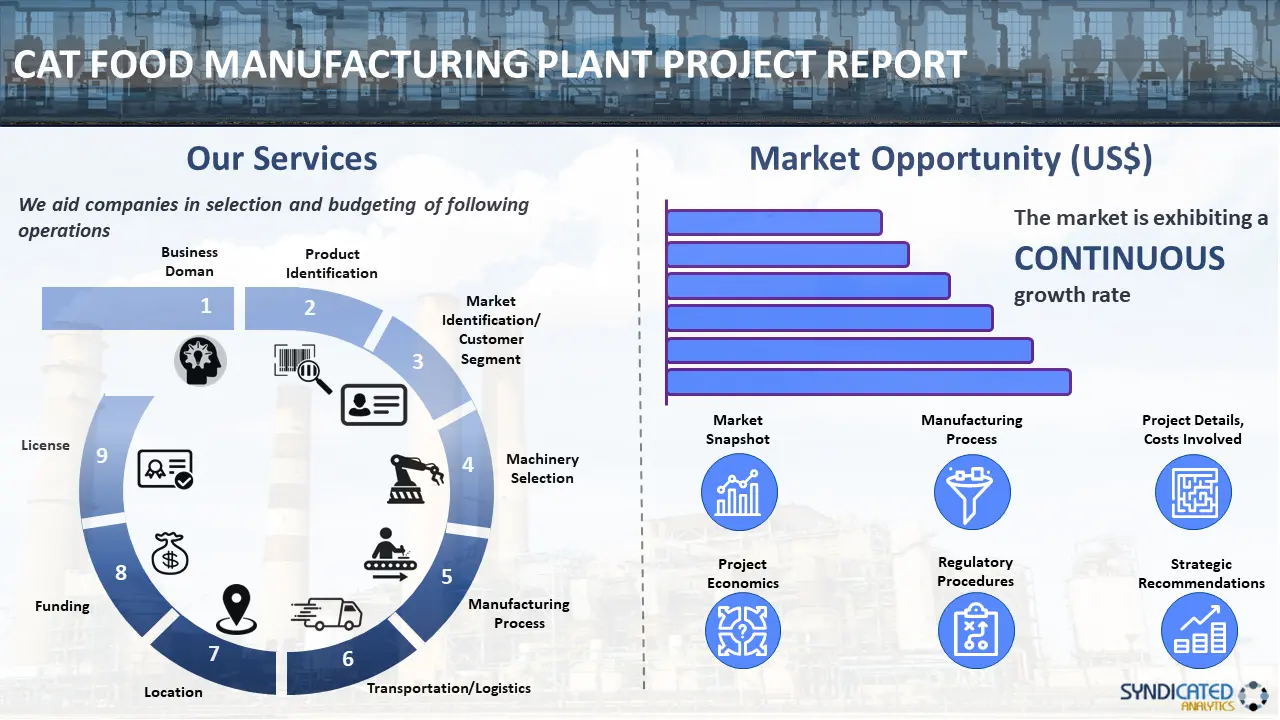
Cat Food Manufacturing Plant Project Report 2025 Edition
Report Coverage: Industry Analysis (Market Performance, Segments, Price Analysis, Outlook), Detailed Process Flow (Product Overview, Unit Operations, Raw Materials, Quality Assurance), Requirements and Cost (Machinery, Raw Materials, Packaging, Transportation, Utility, Human Resource), Project Economics (Capital Investments, Operating Costs, Profit Projections, Financial Analysis, Revenue), and Investment Opportunities
Report Overview:
The new report conducted by Syndicated Analytics, titled "Cat Food Manufacturing Plant Project Report 2025 Edition: Industry Analysis (Market Performance, Segments, Price Analysis, Outlook), Detailed Process Flow (Product Overview, Unit Operations, Raw Materials, Quality Assurance), Requirements and Cost (Machinery, Raw Materials, Packaging, Transportation, Utility, Human Resource), Project Economics (Capital Investments, Operating Costs, Profit Projections, Financial Analysis, Revenue), and Investment Opportunities," offers a comprehensive guide for establishing a manufacturing plant in the cat food industry. It encompasses a wide-ranging market overview and delves into specific details such as unit operations, raw material requirements, utility needs, infrastructure prerequisites, machinery and technology specifications, workforce demands, packaging prerequisites, transportation logistics, and more.
Furthermore, this report delivers extensive insights into project economics, including capital investments, project financing, operating costs, income and expenditure forecasts, fixed versus variable expenses, direct and indirect outlays, expected return on investment (ROI), net present value (NPV), profit and loss analysis, and comprehensive financial assessment.

Market Analysis
| Current Demand for Cat Food | The report evaluates the existing global demand for cat food. |
| Growth Prospects and Trends | The study delves into the growth prospects and emerging trends within the cat food market, providing insights to guide strategic decision-making. |
| Leading Segment and Regional Analysis | This study presents a concise overview of the key segments and regional influence in the cat food market, providing a comprehensive view of the industry's overall landscape. |
| Competitive Landscape | An analysis of the competitive landscape highlights key players in the cat food manufacturing industry, shedding light on their strategies and market positioning. |
A. Introduction
Cat food refers to food products designed to meet the dietary requirements of felines. It includes a wide range of products, such as dry cat food, wet cat food, and treats or snacks, each tailored to cater to the nutritional needs of cats at different life stages. Cat food is comprised of various ingredients, including a blend of meats, grains, vitamins, and minerals, with added novel proteins, organic materials, and specific formulations for dietary sensitivities. It finds extensive use in various applications, such as weight management, hair fall control, urinary tract health, dental health, and senior cat care. Cat food ensures overall health, supports growth and development, maintains a healthy coat and skin, boosts the immune system, and sustains energy levels. Moreover, it aids in managing specific health conditions, like diabetes and kidney disease. Cat food also provides several advantages, such as improved digestibility, reduced allergy risks, and better palatability.
B. Market Trends/Drivers
The increasing pet ownership across the globe and the rising humanization of pets are major factors propelling the market growth. Moreover, the growing focus on pet health and wellness, as owners seek the best nutritional options for their feline companions, is creating a positive outlook for the market growth. Along with this, the increasing consideration of pets as family members, encouraging them to spend on premium products, is providing a thrust to the market growth. In line with this, the rising demand for premium, organic, and natural cat foods, which offer higher quality and health benefits, is fostering the market growth. Besides this, the growing awareness about pet health issues and the heightened importance of proper nutrition in addressing various health concerns is acting as a growth-inducing factor. Additionally, the increasing recommendations and advice from veterinary and pet nutrition experts for various cat food products are supporting the market growth. Furthermore, the rising demand for specialized products catering to different health needs of cats, such as weight management, digestive health, and age-specific requirements, is catalyzing the market growth. In addition to this, rapid innovations in food processing, packaging, and preservation methods that enable the development of a wider variety of cat food products with longer shelf lives and improved nutritional profiles are positively influencing the market growth.
Market Coverage:
| Current Demand for Cat Food | The report evaluates the existing global demand for cat food. |
| Growth Prospects and Trends | The study delves into the growth prospects and emerging trends within the cat food market, providing insights to guide strategic decision-making. |
| Leading Segment and Regional Analysis | This study presents a concise overview of the key segments and regional influence in the cat food market, providing a comprehensive view of the industry's overall landscape. |
| Competitive Landscape | An analysis of the competitive landscape highlights key players in the cat food manufacturing industry, shedding light on their strategies and market positioning. |
Project Feasibility
| Technical Feasibility | The study outlines the intricacies of cat food manufacturing, outlining the necessary equipment and technological requirements. A clear description of the manufacturing process is provided. |
| Financial Feasibility | The report presents an in-depth financial analysis, including the initial investment required, income and profit projections. These financial insights aim to assist potential investors in assessing the viability of the project. |
| Environmental and Regulatory Considerations | The report also discusses the environmental and regulatory aspects associated with cat food production, ensuring that the project aligns with sustainability and compliance standards. |
Project Implementation
| Location Selection | Choosing the optimal location for the manufacturing plant is crucial. This section explores location-based factors impacting the project's success. |
| Plant Design and Layout | Detailed plant design and layout plans are presented, emphasizing efficient production processes and workspace ergonomics. |
| Procurement of Raw Materials | An overview of the procurement process for raw materials necessary for cat food production is provided, ensuring a smooth supply chain. |
| Production Process | An explanation of the cat food production process is provided in the study, from raw material input to the final product, highlighting key stages and quality control measures. |
| Quality Control Measures | Stringent quality control measures are outlined to ensure the production of high-quality cat food. |
Risk Analysis
| Identification of Potential Risks | Potential risks associated with the project are identified, allowing for proactive risk management strategies. |
| Risk Mitigation Strategies | The report proposes risk mitigation strategies to minimize the impact of identified risks on the project's success. |
Seeking a Tailored Project Report?
While we have endeavored to create a comprehensive report, we acknowledge that each stakeholder may possess unique requirements. In light of this, we offer the option to customize the report to align with your specific needs. You can convey your business specifications to our consultants, and we will furnish you with a personalized scope tailored precisely to your requirements. Some of the common customizations that our clients often request include:
- Tailoring the report to suit the country/region where you intend to establish your plant.
- Adapting the manufacturing capacity of the plant to meet your specific needs.
- Customizing machinery suppliers and costs to align with your requirements.
- Incorporating any additional elements into the existing scope as per your specifications.
Report Scope:
| Features | Details |
|---|---|
| Currency | US$ (Information can also be provided in the local currency) |
| Pricing and Purchase Options | Single User License: US$ 3450 Five User License: US$ 4450 Corporate User License: US$ 5450 |
| Customization Scope | The report can also be customized based on the requirements of the customer. |
| Post-Sale Analyst Support | 12-14 Weeks |
| Delivery Format | PDF and Excel through email (We can also provide the editable version of the report in PPT/Word format on special request) |
Questions Addressed in the Report:
- What has been the performance of the cat food market to date, and what are the projections for its future growth?
- How is the cat food market segmented globally?
- How is the cat food market distributed across various regions?
- What trends are observed in the pricing of different feedstocks within the cat food industry?
- What constitutes the structure of the cat food industry, and who are its major stakeholders?
- What key operations are necessary for manufacturing cat food?
- How much land is required to establish a cat food manufacturing plant?
- What is the planned layout for a cat food manufacturing plant?
- What equipment is essential for starting a cat food manufacturing plant?
- What materials are needed to begin production in a cat food manufacturing plant?
- What are the packaging necessities for a cat food manufacturing plant?
- What transportation logistics are required for a cat food manufacturing plant?
- What utilities are needed to operate a cat food manufacturing plant?
- What staffing is necessary for the operation of a cat food manufacturing plant?
- What are the estimated infrastructure costs for establishing a cat food manufacturing plant?
- What initial investments are necessary for setting up a cat food manufacturing plant?
- What will the ongoing operational expenses be for a cat food manufacturing plant?
- How should be the pricing structure for the final product in the cat food industry?
- What are the expected revenues and costs associated with running a cat food manufacturing plant?
- How long will it take for the plant to reach the break-even point?
- What are the forecasted profits from establishing a cat food manufacturing plant?
- What factors determine success and what risks exist in the cat food industry?
- What regulations must be complied with to establish a cat food manufacturing plant?
- What certifications are necessary to operate a cat food manufacturing plant?
Why Choose Syndicated Analytics:
- Our reports offer valuable insights to stakeholders, enabling them to make informed business decisions confidently.
- We maintain a robust network of consultants and domain experts spanning over 100 countries across North America, Europe, Asia Pacific, South America, Africa, and the Middle East.
- Our extensive database includes equipment, and raw material suppliers from major continents, ensuring comprehensive coverage.
- We diligently track and update critical factors such as land costs, raw material costs, construction costs, utility expenses, labor costs, and more, across more than 100 countries worldwide.
- Syndicated Analytics is the trusted partner of choice for leading corporations, governments, and institutions globally. Our clientele ranges from small startups to Fortune 500 companies.
- Our dedicated in-house team comprises experts in various fields, including engineers, statisticians, modeling specialists, chartered accountants, architects, and more. They play a pivotal role in developing, expanding, and optimizing sustainable manufacturing facilities worldwide.
Purchase Options
Ask For Customization
Personalize this research
Triangulate with your own data
Get data as per your format and definition
Gain a deeper dive on a specific application, geography, customer or competitor
Any level of personalization
Get in Touch
Call us on
US: +1-213-316-7435
Uk: +44-20-8040-3201
Drop us an email at
sales@syndicatedanalytics.com